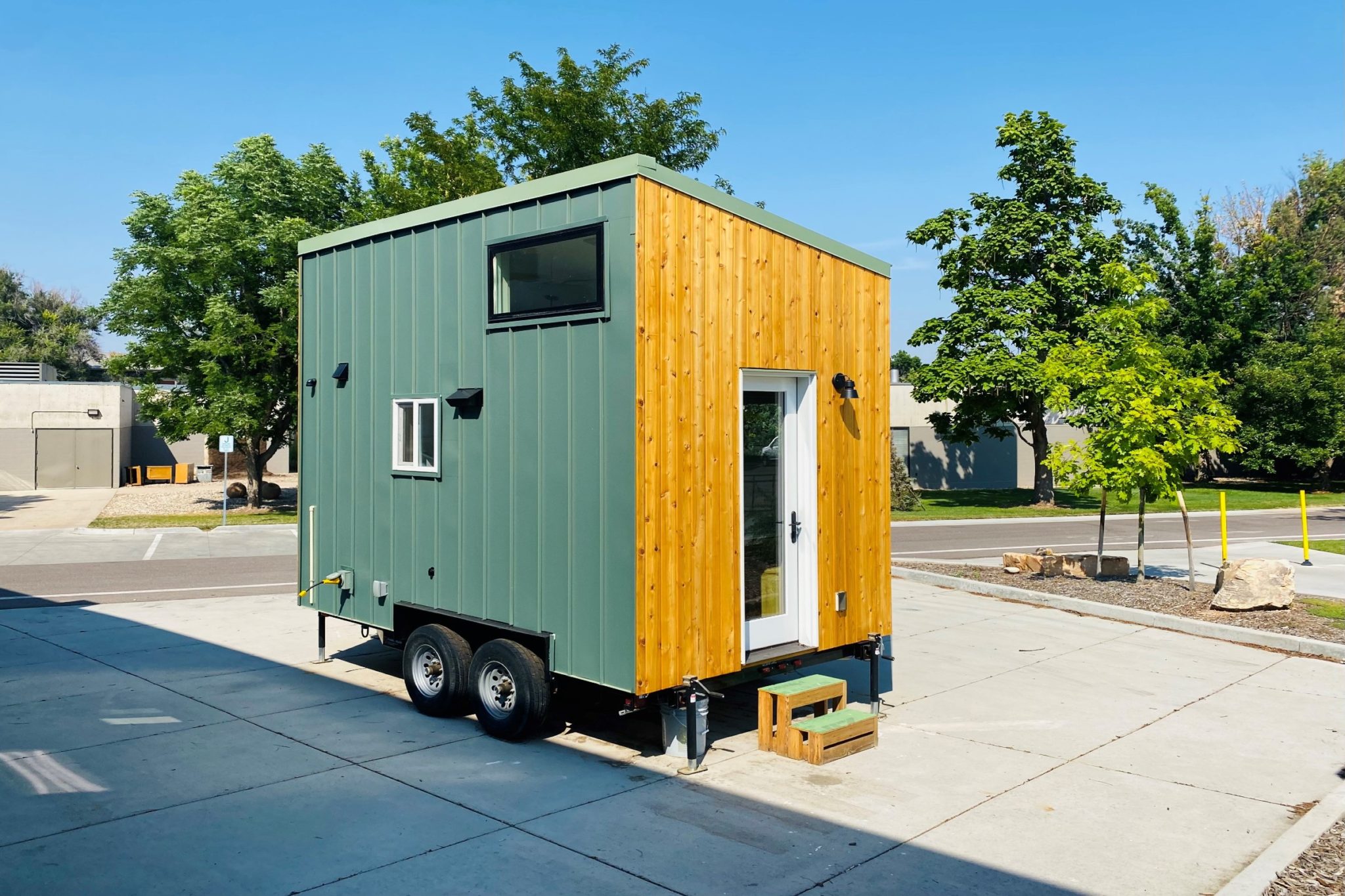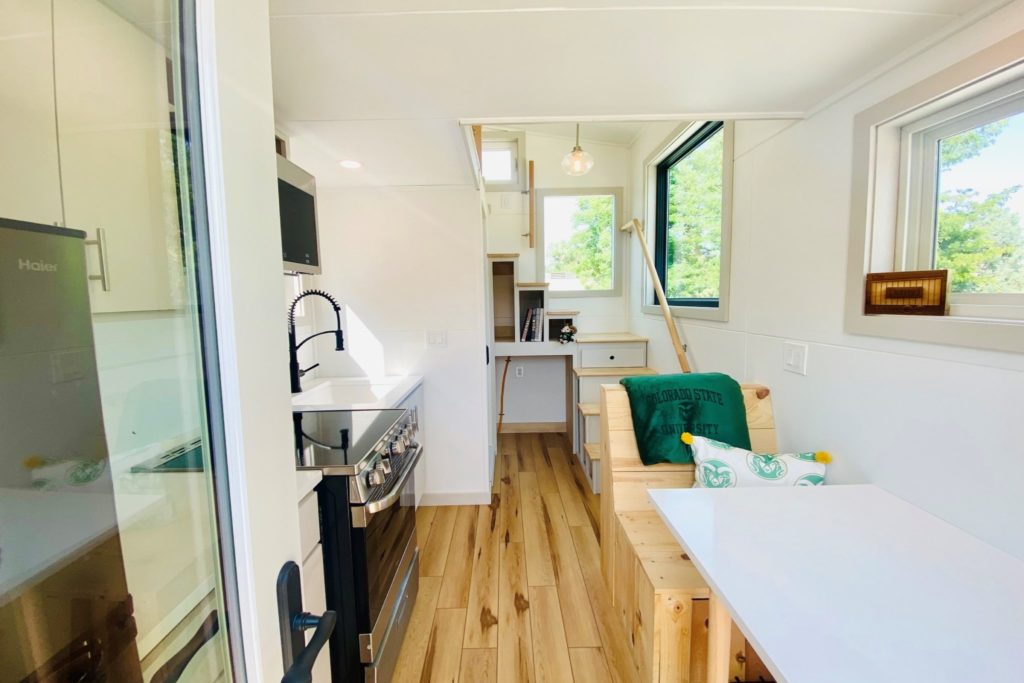
The tiny house movement has taken the nation by storm and the students and faculty at Colorado State University are leading the charge. Here at CSU, the tiny house project brings students together from many disciplines to increase awareness and discussion around Fort Collins’ affordable housing problem. The project educates and inspires students through its hands-on, collaborative process while also raising awareness around the social and environmental issues facing our community. Now, the community has the opportunity to help this project grow through the sale of the house.
Get caught up on the tiny house project
In the spring of 2021, twenty-four CSU students from eight areas of study came together in the IDEA 450 Design Thinking Collaborative course to build a tiny house. The class is the capstone course for the Design Thinking Minor in the Nancy Richardson Design Center (RDC). The course was co-led by Assistant Professor Maria Delgado, from the Department of Design and Merchandising and Mitch Holmes owner of MitchCraft Tiny Homes. Throughout the spring semester, the students designed, sourced, and built a certified and functioning tiny home.
The project garnered a lot of excitement and was featured in both SOURCE and the Coloradoan. The students in the course even built a website and an Instagram account to document the tiny house process. The house has come a long way since last spring. It’s now been certified by the National Organization of Alternative Housing (NOAH) and has been decked out in CSU-themed décor in preparation for its sale.
Nina Struble, a graduate in Interior Architecture and Design, created a video documenting the tiny house process in the midst of COVID-19. The video won first place in the 2021 Interior Design Educators Council (IDEC) Video Competition. Watch the video to see how the team “Created a place that someone will someday call home.”

Tiny house impact
For many students involved in the tiny house project, the hands-on nature of the build contributed to an experiential learning opportunity unlike any they had experienced before. Ragan Funkhouser, a senior majoring in Human Development and Family Studies, explained the project “built my confidence in a lot of building skills like using an impact driver, band saw, and even the table saw.” Dani Michelson, a senior student in the Department of Design and Merchandising studying Interior Architecture and Design, shared: “From the very beginning of the project, I realized that I was involved in something entirely new to me. Many of us, myself included, had the opportunity to expand our knowledge and skills, whether that was learning to use a grinder on steel siding or even being strapped into a harness and operating a scissor lift.”
The inter-disciplinary approach to the build also taught the students many life lessons as they prepare to enter the job market and brought welcome opportunities for collaboration after a year of isolation.
“In regard to learning how to successfully work as a team given our class’s different majors and diverse backgrounds, Dr. Delgado and our adjunct professor Mitch Holmes led by example,” Michelson said. “Together, they worked tirelessly to ensure our safety, to keep the project running smoothly, and to teach each student the foundations of how to build a tiny house. Watching them bring their two skillsets together to create, and see-through, a project of this size taught me perhaps my most important lesson from this class; it is essential to recognize the strengths of your peers, and to use that to your team’s advantage.”
Funkhouser also shared that the inclusion of students from different university disciplines was what allowed her to participate in the program, “One thing that was magical about the class was the inclusion of interdisciplinary majors. If it was just for design majors, I would have never been able to take it and it was sweet getting to know everyone and being able to learn from each other.”
More than anything, the opportunity to be physically present, collaboratively building something, and contributing to the social good of the community was a welcome and exciting opportunity for students that had spent the majority of the year learning remotely in the face of the pandemic. The project generated so much excitement and joy for the students that Funkhouser and her father decided to build their own tiny house this summer; Funkhouser shared that the tiny house build “was one of the hardest and most rewarding things I have done.”
Similarly, Michelson found herself heading over to the tiny house to work on the project even on days they didn’t have class; the project generated so much excitement. “It was an experience that those of us who were involved will never forget,” she said.
Tour the tiny house
The CSU and Fort Collins communities will now have the opportunity to tour the CSU tiny house on CSU’s Homecoming weekend. Tours will happen from 2-4 p.m. on Friday, Oct. 8, and 9 a.m. to 2 p.m. on Saturday, Oct. 9 (note parking is limited on campus on Saturday for CSU’s football game). The CSU tiny house is currently located outside the Nancy Richardson Design Center at 522 West Lake Street, Fort Collins, Colorado 80526, right next to Canvas Stadium. Students who participated in the course will lead the tours.
Tiny house virtual tour
If you are unable to attend the Tiny House Tailgate Tour, you can take a virtual tour. The virtual tour allows for 360-degree rotating views and allows you to zoom in or out so you won’t miss a single detail. Colored Mattertag posts provide additional information with gold tabs sharing product and material donation information, green tabs sharing architecture features, and orange tabs sharing CSU knowledge. The virtual tour has been created with the use of a 3D camera and Matterport technology; this same technology was used to document the Architectural Virtual Library, another project led by Delgado.
Make the tiny house home

If you find yourself falling in love with the CSU tiny house (and it’s hard not to), don’t miss the chance to purchase the house and contribute to the project’s collaborative mission. The RDC has partnered with Shawn and Kari Harger at C3 Real Estate Solutions, to stage and photograph the home. The photos will be used in the informational listing generated by the Hargers to promote the home sale details. The Hargers are CSU alumni and their daughter is a second-year Interior Architecture and Design student. CSU will sell the home and determine the starting price on or around October 5. The team expects high interest in the home.
The tiny house was made possible by fundraising and material donations, but the sale of this house will lead to the growth of the program. Proceeds from the tiny house sale will benefit the educational mission of the Nancy Richardson Design Center and fund the tiny house project for the following year, allowing even more students to take part in a life-changing learning opportunity. If you are interested in purchasing the home, contact Laura Malinin, director of the RDC, at Laura.Malinin@colostate.edu. If you would like to contribute to future tiny house projects, visit csutinyhouse.com for more information on donations and volunteering.
What’s next for the CSU tiny house project?
There are exciting plans in the works for next year’s tiny house project. “Contingent on the 2021 tiny house sale, next year’s student-led design-thinking capstone project will be an accessible tiny house,” said Delgado. “The home will serve to educate students on alternative, inclusive housing needs for Colorado’s older adult population. The second home will also comply with NOAH standards and integrate sustainable design features. If community members are interested in engaging with the 2022 build, please do not hesitate to contact us.”
The Department of Design and Merchandising is part of CSU’s College of Health and Human Sciences.